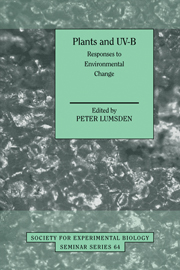Book contents
- Frontmatter
- Contents
- List of contributors
- Preface
- PART I The ozone layer and UV-B radiation
- Global ozone depletion: observations and theory
- Monitoring changes in UV-B radiation
- Action spectra for UV-B effects on plants: monochromatic and polychromatic approaches for analysing plant responses
- PART II Effects of UV-B on plants at the cellular level
- PART III Effects of UV-B at the whole plant and community level
- Index
Global ozone depletion: observations and theory
Published online by Cambridge University Press: 04 August 2010
- Frontmatter
- Contents
- List of contributors
- Preface
- PART I The ozone layer and UV-B radiation
- Global ozone depletion: observations and theory
- Monitoring changes in UV-B radiation
- Action spectra for UV-B effects on plants: monochromatic and polychromatic approaches for analysing plant responses
- PART II Effects of UV-B on plants at the cellular level
- PART III Effects of UV-B at the whole plant and community level
- Index
Summary
Introduction
It is now well known that ozone concentrations in the stratosphere have declined during the last 25 years as a consequence of the emission into the atmosphere of a variety of chlorine-and bromine-containing compounds. This decline in the thickness of the ozone layer could have important consequences. Firstly, ozone is an important climate gas. Absorption of solar radiation by ozone controls the temperature of the stratosphere and leads directly to the stable stratification of the stratosphere. Changes in ozone can be expected to lead to changes in the climate of the stratosphere; these changes may also be important for the circulation of the troposphere and hence for weather. In addition, ozone is a greenhouse gas, absorbing radiation in the infra-red region of the spectrum. A decrease of ozone in the lower stratosphere can act to cool the climate system, counteracting the impact of the growth of carbon dioxide and other greenhouse gases. Secondly, because ozone absorbs solar ultra-violet radiation, any reduction in the stratospheric ozone abundance will lead to enhanced intensity of ultra-violet radiation at the surface. Biological systems are particularly sensitive to short wavelength radiation at less than about 300 nm. Increases in the intensity at these wavelengths may have an influence on the health of humans, of plants (see later chapters in this volume) and of other animals.
- Type
- Chapter
- Information
- Plants and UV-BResponses to Environmental Change, pp. 3 - 12Publisher: Cambridge University PressPrint publication year: 1997
- 14
- Cited by

